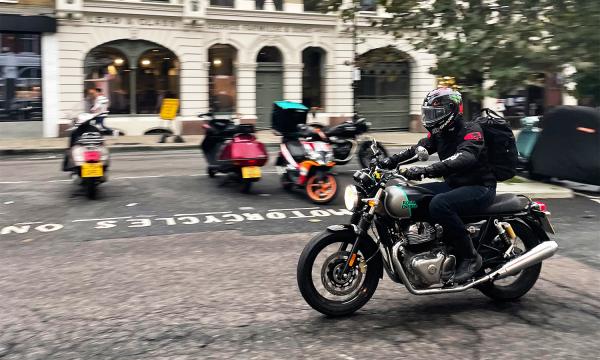
Although ULEZ began as an area which covered only Central London, it has since expanded twice, and since 29 August 2023 it has covered all London boroughs, changing drastically how Londoners travel, including for those whose primary means of transport is a motorcycle.
In this article, we’ll take you through all you need to know about the ULEZ, why it’s opposed, how to work out if you have to pay, and what all of it means for bikers.
ULEZ Overview - links to sections for information
- What is the ULEZ?
- Does it include motorcycles?
- Why was it introduced?
- Why do people oppose it?
- Why is it expanding?
- Where is it expanding to?
- Are there ways around the ULEZ fees?
- How to check if your vehicle is compliant
- Can you challenge TfL's judgement on your vehicle?
- Can your motorcycle be upgraded to meet ULEZ standards?
- Scrappage scheme
- How to pay
What is the ULEZ?
ULEZ signs. - "ULEZ Zone" by Matt From London is licensed under CC BY 2.0.
The Ultra Low Emission Zone, or ULEZ, is, in the most basic terms, a particular area of London in which charges are applied to the owners of vehicles travelling through it which exceed a threshold for emissions.
It was established in 2019, however, it had first been proposed in 2013 by the then-Mayor of London Boris Johnson as an evolution of the Low-Emission Zone - introduced in 2008 - that had preceded it.
Johnson’s original plans, formulated in 2015, had 2020 as the date for the introduction of the ULEZ in London. However, this changed when Sadiq Khan became Mayor of London in 2016. He decided to bring forward the introduction of the zone to 2019.
Since then, the ULEZ has undergone one expansion, which took it from only central London to all areas within the North and South Circular roads. But the second expansion, which came into force at midnight on the morning of 29 August 2023, increases its coverage across all London boroughs.
Does any of this matter for motorcycles?
Yes. Unlike the Congestion Charge, for which the size of a motorcycle is of benefit in terms of achieving exemption, the ULEZ is concerned specifically with the amount of nitrogen oxide (NOx) and PM2.5 (fine particles, from tyres and brakes, for example) emissions your vehicle produces.
If your vehicle is deemed to produce too many, then it is eligible to be charged the £12.50 daily fee. That counts for motorcycles just as much as it does for cars.
Generally speaking, pre-Euro3 motorcycles are non-compliant, and everything meeting Euro3-and-later emissions standards and registered in or after 2007 will be compliant with the ULEZ regulations, and will therefore not require a fee to be paid.
Why was the ULEZ introduced?
The answer to the above question is quite simple. The intention of the ULEZ is to reduce emissions and save lives.
The theory is that by limiting areas of London to lesser-polluting vehicles - or at least limiting the amount of higher-polluting vehicles in those areas - the air in those areas should become cleaner, and should therefore cause less damage to the lungs of the people living and working in those areas, thus improving their health and prolonging their lives. This is the theory.
Why do people oppose the ULEZ?
If the answers to the previous two questions were simple, then this one is, too: cost.
Inflation is a simple part of capitalist reality, and in the post-Covid world that inflation has been particularly severe. The result has been a cost of living crisis, which has reduced the enthusiasm of people living and working currently outside the Zone to begin paying the charge for being within the Zone having not actually changed anything themselves.
This leads to the second answer to this question, that people feel that ULEZ is something being forced on them, and not something that they have wanted or asked for. In fact, ULEZ was blamed even by MPs of Sadiq Khan’s own party, Labour, for its loss of the Uxbridge by-election in July 2023.
But, coming back to the original point - cost - the daily fee for driving a non-ULEZ-compliant vehicle in the ULEZ is £12.50, which, alone, sounds affordable, but which, when contextualised over longer periods of time, quickly becomes much less affordable for many people.
For example, if you travel through the ULEZ five days per week for work in or on a vehicle which is non-ULEZ-compliant you will be paying £67.50 per week. If you repeat that over 48 weeks, £3,240 will be spent only on ULEZ fees.
Why is the ULEZ expanding?
Simply, research conducted by Transport for London (TfL) found that more health issues are caused by air pollution in the outer boroughs of London compared to those already within the ULEZ. Therefore, the expansion of the ULEZ should improve the air quality in the outer London areas, and reduce the number of health issues related to air pollution in those areas as a result.
Where is the ULEZ expanding to?
ULEZ expansion map. Inner-most ring is the original ULEZ, middle ring is ULEZ after first expansion, outer ring is ULEZ after 29 August 2023 expansion.
On 29 August, the ULEZ expanded from its current area, which includes everything within the North and South Circular roads (but not the North and South Circular roads themselves), to encompass all 32 London boroughs.
For clarity, the 32 London boroughs that will be inside the ULEZ from 29 August 2023 are:
- Camden
- Royal Borough of Greenwich
- Hackney
- Hammersmith and Fulham
- Islington
- Royal Borough of Kensington and Chelsea
- Lambeth
- Lewisham
- Southwark
- Tower Hamlets
- Wandsworth
- City of Westminster
- Barking and Dagenham
- Barnet
- Bexley
- Brent
- Bromley
- Croydon
- Ealing
- Enfield
- Haringey
- Harrow
- Havering
- Hillingdon
- Hounslow
- Royal Borough of Kingston upon Thames
- Merton
- Newham
- Redbridge
- Richmond upon Thames
- Sutton
- Waltham Forest
Are there ways around the ULEZ fees?
Fundamentally, to avoid paying the ULEZ fees you must not travel through the ULEZ in a vehicle which is non-ULEZ-compliant.
To achieve this, there are many options. For example, you could buy a vehicle which is ULEZ-compliant; or, if that is not an option and you are forced to stick with your non-compliant vehicle, you could simply avoid travelling through London at all. Or, you could use public transport.
From a motorcycle perspective, bikes which are more than 40-years-old are considered to be historic and are therefore exempt from the charges regardless of the actual compliance of their engine. So, if you have a non-compliant 1984 Kawasaki GPZ900R, simply swap it for a 1983 Kawasaki GPZ750, which is still not compliant with the ULEZ thresholds but is 40-years-old, and therefore exempt for its historicity.
How do I check if my vehicle is compliant?
You can head to the TfL website to check the compliance of your vehicle. All you need is your vehicle’s registration number.
As mentioned above, generally speaking, pre-Euro3 motorcycles are non-compliant. On the other hand, everything meeting Euro3-and-later (newly manufactured motorcycles must now comply with Euro5) emissions standards and registered in or after 2007 will be compliant with the ULEZ regulations, and will therefore not require a fee to be paid. Of the emissions measured in Euro3 - which was introduced in 2000 - the nitrogen oxide figure is the one which it is essential to comply with in terms of complying with the ULEZ regulations.
Petrol engine Euro3 emissions standards
- Carbon monoxide (CO): 2.3g/km
- Total hydrocarbons (THC): 0.20g/km
- Nitrogen oxides (NOx): 0.15g/km
That is not to say that all pre-2007 Euro3 bikes are non-compliant. There are numerous motorcycles from before 2007 which meet the requirements. So, if you own a Euro3 bike from 2006 or earlier it is definitely worth heading to TfL’s website to check its compliance - you might get a nice surprise!
TfL says my bike is non-compliant, but I think it is compliant.
In this case, contact your motorcycle’s manufacturer. Any evidence the manufacturer is able to supply you that supports your claim that your bike is compliant will be accepted by TfL when presented to them.
You can register your vehicle for ULEZ on the TfL website.
Can my non-compliant bike be modified to be compliant with ULEZ?
Yes. Riverbank Motorcycles, which was also the first place to offer ULEZ emission testing, offers a service which can reduce the NOx emissions of your motorcycle. The service does not work for all bikes, depending on their emission levels, but it could be worth giving Riverbank a visit or a call to see if they can help you out.
Is there support to help people get rid of non-compliant vehicles?
To an extent. There is a scrappage scheme for ULEZ, with £110 million currently put up by the Mayor of London. That is also set to increase to £160 million.
Currently, the car and motorcycle scrappage scheme is only open to people receiving Child Benefit, or certain low-income or disability benefits. However, from 21 August, the applications will be opened to all Londoners. Up to £1,000 can be awarded for scrapping a motorcycle.
After the aforementioned Uxbridge by-election, Labour deputy leader Angela Rayner suggested that the scrappage scheme could be further adjusted to make changing to ULEZ-compliant transport more affordable for more people.
I own a non-compliant vehicle and will not be changing it. How do I pay the fee?
There are several ways to pay the £12.50 daily fee for travelling through the ULEZ with a non-compliant vehicle.
Firstly, there is an online option on the TfL website. The TfL app can also be used - this is the same app that is used to pay the Congestion Charge.
Auto Pay is a convenient option, but it does come with an additional annual charge of £10.
The final option is to pay by phone. Numbers for this are as follows:
o UK (TfL call charges apply): 0343 222 2222
o International: +44 343 222 2222
o Textphone (for those with impaired hearing): 020 7649 9123
If you are required to make the payment but do not make it, you will be fined £160. This is reduced to £80 if you pay the fine within 14 days.

